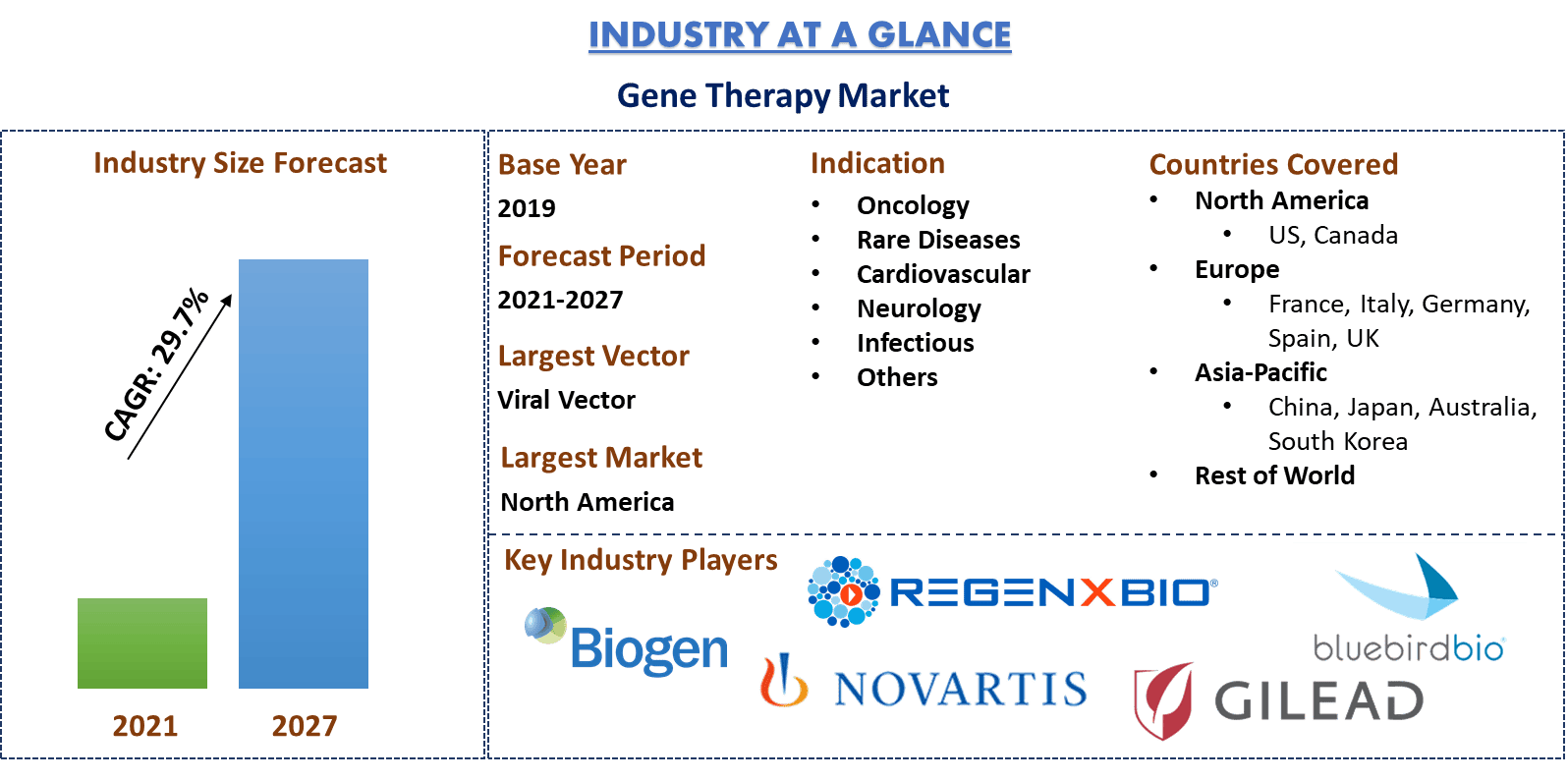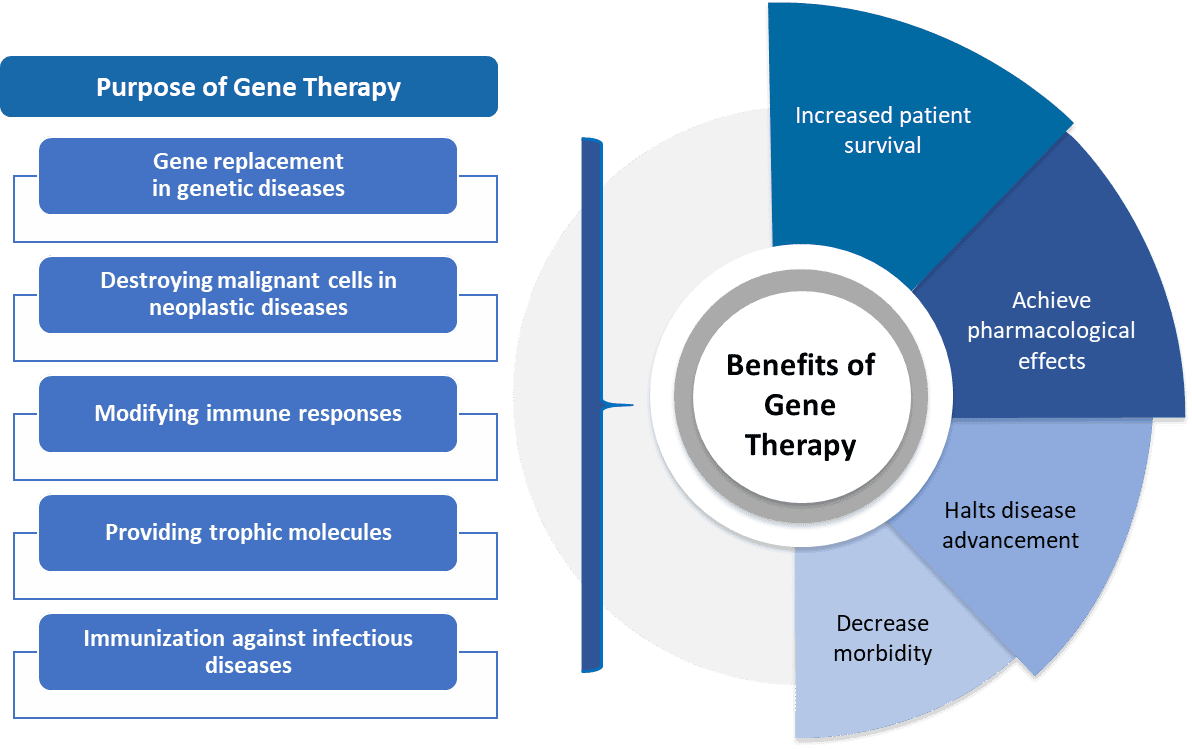- Home
- About Us
- Industry
- Services
- Reading
- Contact Us
Gene Therapy Market Current Analysis and Forecast 2020-2027
Emphasis on Vector [Viral (Lentivirus, Adeno-Associated Virus, Retrovirus & Gammaretrovirus, Modified Herpes Simplex Virus, Adenovirus), Non-Viral], Gene Type (Antigen, Cytokine, Tumor Suppressor, Suicide, Deficiency, Receptor, Others), Indication (Oncology, Rare Diseases, Cardiovascular, Neurology, Infectious, Others), Delivery Method (In vivo, Ex vivo) and Region/Country

Global Gene Therapy Market is expected to reach the market valuation of US$ 20.9 billion by 2027 expanding at a reasonable CAGR of 29.7% during the forecast period (2021-2027) from US$ 3.5 billion in 2019. Gene therapy inserts genetic material into cells to compensate for abnormal genes or to make a beneficial protein. The increasing number of clinical trials that are underway and tremendous mergers, acquisitions, and venture capital investments in the gene-therapy sector make the future looks bright for such therapies. To date, approximately 2,600 gene therapy clinical studies have been completed, are ongoing, or have been approved globally. More than ever, the field of gene therapy seeks to identify a route to the clinic and the market. Approximately 20 gene therapies have now been licensed and over two thousand clinical trials of human gene therapy have been published globally. Such advancements generate great hope that debilitating rare and inherited disorders as well as incurable diseases can be treated.
According to the Alliance for Regenerative Medicine (ARM) Quarterly Regenerative Medicine Global Data Report for the first quarter of 2019, 372 gene therapy clinical trials were in progress as of the end of Q1. Remarkably, a margin (217 or 58%) were studies in Phase II, followed by Phase I (123 or 33%), and Phase III (32 or 9%). The number of gene therapy clinical trials edged up by 10 from the 362 recorded as of the end of 2018. Substantially, the number of clinical studies leaped 17% year-over-year from the 319 trials in development as of Q1 2018. Many of the clinical trials in gene therapy have been aimed at the treatment of cancer indications including lung, gynecological, skin, urological, neurological, and gastrointestinal tumors, as well as hematological malignancies and pediatric tumors. The International Agency for Research on Cancer estimates that worldwide, 1 in 5 people is intended to develop cancer during their lifetime, and 1 in 8 men and 1 in 11 women die from the disease. These new evaluations indicate that approximately 50 million people are living within 5 years of a past cancer diagnosis. Aging populations worldwide and socio-economic risk factors remain among the primary influences driving this surge.
Purpose and Benefits of Gene Therapy

Biogen, BioMarin Pharmaceuticals, bluebird bio, Bristol Myers Squibb, Gilead Sciences, Novartis, Orchard Therapeutics, Regenxbio, Spark Therapeutics, and uniQure are some of the prominent players operating in the global gene therapy market. Several M&A’s along with partnerships have been undertaken by these players to facilitate costumers with hi-tech and innovative products.
Insights Presented in the Report
“Amongst vectors, Viral vectors segment holds the major share”
Based on the vector type, the market is fragmented into viral and non-viral vectors. The viral vectors dominated the market with a share of 88.6% in 2019 and are expected to maintain their dominance during the forecast period owing to the significant improvements in vector engineering, delivery, and safety.
“Amongst viral vectors, adeno-associated virus vectors are anticipated to dominate the market during the analyzed period”
Furthermore, the viral vector market is mainly bifurcated into the lentivirus, adeno-associated virus, retrovirus & gammaretrovirus, modified herpes simplex virus, and adenovirus. In 2019, adeno-associated virus sub-segment accounted for a maximum market revenue share of 34% and is expected to remain dominant during the analyzed period owing to the easy integration into the host genome, no viral genes, able to transduce cells not actively dividing, a wide range of host cells, and being non-inflammatory and non-pathogenic. However, the non-viral vector is anticipated to grow at the highest CAGR over the forecast period.
“Amongst gene type, antigen segment dominated the market during the forecast period”
Based on gene type, the market is mainly fragmented into antigen, cytokine, tumor suppressor, suicide, deficiency, receptor, and others. In 2019, the antigen segment accounted for a maximum market revenue share of 19.2% and is expected to remain dominant during the analyzed period.
“Amongst indication, oncology segment holds the major share”
Based on indication, the market is bifurcated into oncology, rare diseases, cardiovascular, neurology, infectious, and others. In 2019, the oncology segment accounted for the maximum market share with 48.6% and is expected to be the leading segment of the gene therapy market during the forecast period due to the increasing incidence of cancer cases.
“Amongst the delivery method, in-vivo segment dominated the market during the forecast period”
Based on the delivery method, the market is mainly disintegrated into in-vivo and ex-vivo. In 2019, in-vivo segment accounted for a maximum market revenue share of 87.5% and is expected to remain dominant during the analyzed period owing to the direct transfer of genes into patients.
“North America represents one of the largest markets of Gene Therapy market”
For a better understanding of the market dynamics of the gene therapy market, a detailed analysis was conducted for different regions across the globe including North America (the U.S, Canada, and the Rest of North America), Europe (Germany, France, Italy, Spain, United Kingdom and Rest of Europe), Asia-Pacific (China, Japan, Australia, South Korea, and Rest of APAC), Rest of World has been conducted. North America dominated the market and generated revenue of US$ 1.7 billion in 2019 owing to the high prevalence rate of cancer, presence of high disposable income, and increase in funding for R&D activities associated with gene therapy.
Reasons to buy this report:
- The study includes market sizing and forecasting analysis validated by authenticated key industry experts
- The report presents a quick review of overall industry performance at one glance
- The report covers an in-depth analysis of prominent industry peers with a primary focus on key business financials, product portfolio, expansion strategies, and recent developments
- Detailed examination of drivers, restraints, key trends, and opportunities prevailing in the industry
- The study comprehensively covers the market across different segments
- Deep dive regional level analysis of the industry
Customization Options:
The Gene Therapy Market can further be customized as per the requirement or any other market segment. Besides this, UMI understands that you may have your own business needs, hence feel free to connect with us to get a report that completely suits your requirements.
Table of Content
Analyzing the historical market, estimation of the current market, and forecasting the future market of the Global Gene Therapy Market were the three major steps undertaken to create and analyze the adoption of gene therapy for the different diseases across major regions globally. Exhaustive secondary research was conducted to collect the historical market numbers and estimate the current market size. Secondly, to validate these insights, numerous findings and assumptions were taken into consideration. Moreover, exhaustive primary interviews were also conducted, with industry experts across the value chain of the gene therapy sector. Post assumption and validation of market numbers through primary interviews, we employed a top-down approach to forecast the complete market size. Thereafter, market breakdown and data triangulation methods were adopted to estimate and analyze the market size of segments and sub-segments the industry pertains to. Detailed methodology is explained below:
Analysis of Historical Market Size
Step 1: In-Depth Study of Secondary Sources:
Detailed secondary study was conducted to obtain the historical market size of the gene therapy through company internal sources such as annual report & financial statements, performance presentations, press releases, etc., and external sources including journals, news & articles, government publications, competitor publications, sector reports, third-party database, and other credible publications.
Step 2: Market Segmentation:
After obtaining the historical market size of the gene therapy market, we conducted a detailed secondary analysis to gather historical market insights and share for different segments & sub-segments for major regions. Major segments included in the report are vector, gene type, indication, and delivery method. Further country-level analyses were conducted to evaluate the overall adoption of gene therapy in that region.
Step 3: Factor Analysis:
After acquiring the historical market size of different segments and sub-segments, we conducted a detailed factor analysis to estimate the current market size of gene therapy. Further, we conducted factor analysis using dependent and independent variables such as the rising prevalence of cancer and other rare diseases. A thorough analysis was conducted for demand and supply-side scenario considering top partnerships, merger and acquisition, business expansion, and product launches in the gene therapy industry across the globe.
Current Market Size Estimate & Forecast
Current Market Sizing: Based on actionable insights from the above 3 steps, we arrived at the current market size, key players in the gene therapy market, and market shares of the segments. All the required percentage shares split, and market breakdowns were determined using the above-mentioned secondary approach and were verified through primary interviews.
Estimation & Forecasting: For market estimation and forecast, weights were assigned to different factors including drivers & trends, restraints, and opportunities available for the stakeholders. After analyzing these factors, relevant forecasting techniques i.e. top-down approach was applied to arrive at the market forecast about 2027 for different segments and subsegments across the major markets globally. The research methodology adopted to estimate the market size encompasses:
- The industry’s market size, in terms of value (US$) and the adoption rate of gene therapy across the major markets domestically
- All percentage shares, splits, and breakdowns of market segments and sub-segments
- Key players in the gene therapy market in terms of services offered. Also, the growth strategies adopted by these players to compete in the fast-growing market
Market Size and Share Validation
Primary Research: In-depth interviews were conducted with the Key Opinion Leaders (KOLs) including Top Level Executives (CXO/VPs, Sales Head, Marketing Head, Operational Head, and Regional Head, Country Head, etc.) across major regions. Primary research findings were then summarized, and statistical analysis was performed to prove the stated hypothesis. Inputs from primary research were consolidated with secondary findings, hence turning information into actionable insights.
Split of Primary Participants in Different Regions
Market Engineering
Data triangulation technique was employed to complete the overall market estimation and to arrive at precise statistical numbers of each segment and sub-segment of the gene therapy market. Data was split into several segments & sub-segments post studying various parameters and trends in the areas of vector, gene type, indication, and delivery method of the gene therapy market.
Main Objective of the Gene Therapy Market Study
The current & future market trends of gene therapy were pinpointed in the study. Investors can gain strategic insights to base their discretion for investments from the qualitative and quantitative analysis performed in the study. Current and future market trends were determined the overall attractiveness of the market at a regional level, providing a platform for the industrial participant to exploit the untapped market to benefit as a first-mover advantage. Other quantitative goals of the studies include:
- Analyze the current and forecast market size of gene therapy in terms of value (US$). Also, analyze the current and forecast market size of different segments and sub-segments
- Segments in the study include areas of vector, gene type, indication, and delivery method
- Define and analysis of the regulatory framework for the gene therapy industry
- Analyze the value chain involved with the presence of various intermediaries, along with analyzing customer and competitor behaviors of the industry
- Analyze the current and forecast market size of the gene therapy market for the major region
- Major regions studied in the report include North America (the U.S and Canada), Europe (Germany, France, Italy, Spain, and United Kingdom), Asia-Pacific (China, Japan, Australia and South Korea), Rest of the World
- Company profiles of the gene therapy market and the growth strategies adopted by the market players to sustain in the fast-growing market
- Deep dive regional level analysis of the industry
Related Reports
Customers who bought this item also bought











